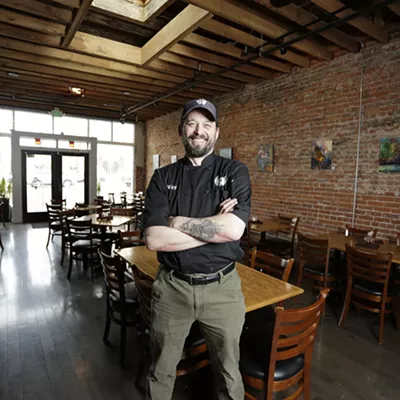Considering the complex factors behind food waste, you'd be forgiven for assuming that grocery stores and restaurants — which both move a lot of food every day — are the issue's biggest contributors.
It's actually us, the consumers, mostly responsible (43 percent), while restaurants take second place at 18 percent. Grocery stores and distributors, meanwhile, contribute to 13 percent of total food waste, according to the nonprofit Natural Resource Defense Council's 2017 update on its groundbreaking 2012 report, "Wasted: How America is Losing Up to 40 Percent of Its Food From Farm to Fork to Landfill."
"I think [shoppers] look at a case of product and think, 'What happens when this doesn't sell? They might just throw it all away,'" notes Rosauers Supermarkets CEO and President Jeff Philipps.
"In reality, we mark it down so it does sell to customers, or we repurpose it where it's possible, or we get it to people who can actually consume it through a food bank process."
Rosauers' donation partners include larger food banks like Second Harvest and Spokane Valley Partners, along with smaller regional pantries.
Philipps wasn't able to say how much food the regional grocery chain, which operates 21 stores across Eastern Washington, Idaho and Western Montana, ends up actually throwing away each week.
"While it's a large number, I think it's less than what people would anticipate," he says.
To prevent such excess to begin with, department managers at each Rosauers store carefully track inventory and ordering to ensure that food is sold before the need occurs to discount or donate.
"Fast movers tend not to be a problem. When you have an issue, typically its specialty products that don't sell rapidly," Philipps notes.
Food that's getting close to being outdated is also often repurposed by the deli department into premade dishes, or other products, like turning extra steak into ground beef.
After all, it's in Rosauers' and other food retailers' best interest to avoid throwing any surplus into the trash. Grocers get tax breaks for the value of items donated to food banks. After that, food which doesn't sell becomes a profit-margin loss.
Single-location grocers like My Fresh Basket in Kendall Yards undertake similar practices for repurposing excess inventory.
Store manager Matt Grittner estimates My Fresh Basket is forced to, on average, dispose of less than 500 pounds of mostly nonedible food per week that couldn't otherwise be redistributed through nonprofit partners. Its main donation outlet is Our Place Community Ministries in West Central Spokane, along with area farms and animal rescues that use expired or nonsaleable produce for animal feed.
"I think a lot of stores are doing better donating product," Grittner notes. "I think what most stores toss is stuff you wouldn't even want to donate; it's beyond that point."
Restaurants may be the second largest contributor of wasted food in America, but not all of them are over-ordering ingredients and over-serving diners.
In Spokane, Wiley's Downtown Bistro chef-owner Michael Wiley won't order an ingredient for his kitchen unless it's featured in at least three dishes on the menu.
"The biggest thing I know we can control is that we try and make sure we are reducing waste before it ever gets made," Wiley notes. "If customers don't finish their dinner, we're serving too much food, so we try and control that as far as portioning goes."
If the kitchen ends up with still-fresh, leftover ingredients from one dish, Wiley looks for a way to repurpose them into another dish, perhaps for the next day's special.
He also keeps his menu pared down, offering on average seven dinner entrees, six to seven appetizers and only seven different sandwiches for lunch.
"I feel like a lot of restaurants you go to and look at the menu, and it's decision fatigue figuring out what you want," he says. "But there is also a lot of waste in the utilization of ingredients" for each dish that need to be readily available at all times.
Wiley's isn't the only area restaurant keeping its menu concise and thus its food turnover quick, leading to fresher ingredients and less waste. Similar practices are happening at many others, the most noticeable to consumers being shorter, concise menus.
At Boots Bakery & Lounge in downtown Spokane, stocking only what's needed to make dishes sold each day from its cold and bakery cases is not only an environmentally conscious choice of owner Alison Collins, but one of necessity. The counter-service restaurant's kitchen is tiny.
"We get produce every day," Collins says. "We get it from farmers during the months we can, and local people bring in what they're growing."
When, say, a local farmer calls her up and says they have a bunch of extra tomatoes or rhubarb and asks if she wants it, she'll figure out how to incorporate it into the week's menu.
"We can make whatever we feel like, which helps with not wasting," Collins says. "As far as what we make, it's rare when we have something leftover.
"I think that's because we make food every day and it's constantly rotating and we don't make too much," she continues. "We don't even contribute to Feed Spokane because we don't have 'waste.' It's a good problem to always be running out of food versus throwing it away."
Outside of what she can control via ordering, planning and creative cooking, Collins and her team try not to over-serve customers. Portions for its cold-case dishes, which can be ordered as a single side or in combos of two to three different dishes, are measured out in quarter-cup scoops.
"Some even say they're too small, but if you have three quarter-cup servings, that is very filling," she says. "I think people are so accustomed to [ordering] a hummus plate and it's enough for four." ♦



























